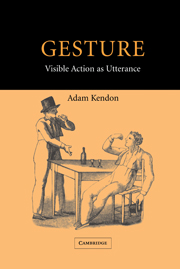Book contents
- Frontmatter
- Contents
- Acknowledgments
- 1 The domain of gesture
- 2 Visible action as gesture
- 3 Western interest in gesture from Classical Antiquity to the eighteenth century
- 4 Four contributions from the nineteenth century: Andrea de Jorio, Edward Tylor, Garrick Mallery and Wilhelm Wundt
- 5 Gesture studies in the twentieth century: recession and return
- 6 Classifying gestures
- 7 Gesture units, gesture phrases and speech
- 8 Deployments of gesture in the utterance
- 9 Gesture and speech in semantic interaction
- 10 Gesture and referential meaning
- 11 On pointing
- 12 Gestures of ‘precision grip’: topic, comment and question markers
- 13 Two gesture families of the open hand
- 14 Gesture without speech: the emergence of kinesic codes
- 15 ‘Gesture’ and ‘sign’ on common ground
- 16 Gesture, culture and the communication economy
- 17 The status of gesture
- Appendix I Transcription conventions
- Appendix II The recordings
- References
- Index
10 - Gesture and referential meaning
Published online by Cambridge University Press: 05 February 2015
- Frontmatter
- Contents
- Acknowledgments
- 1 The domain of gesture
- 2 Visible action as gesture
- 3 Western interest in gesture from Classical Antiquity to the eighteenth century
- 4 Four contributions from the nineteenth century: Andrea de Jorio, Edward Tylor, Garrick Mallery and Wilhelm Wundt
- 5 Gesture studies in the twentieth century: recession and return
- 6 Classifying gestures
- 7 Gesture units, gesture phrases and speech
- 8 Deployments of gesture in the utterance
- 9 Gesture and speech in semantic interaction
- 10 Gesture and referential meaning
- 11 On pointing
- 12 Gestures of ‘precision grip’: topic, comment and question markers
- 13 Two gesture families of the open hand
- 14 Gesture without speech: the emergence of kinesic codes
- 15 ‘Gesture’ and ‘sign’ on common ground
- 16 Gesture, culture and the communication economy
- 17 The status of gesture
- Appendix I Transcription conventions
- Appendix II The recordings
- References
- Index
Summary
In the previous chapter, using a single example as an illustration, we noted at least four different ways in which representational gestures collaborated with the verbal component of an utterance to contribute to its referential meaning. We saw how M used a gesture as an object of deictic reference for a verbal expression, how he used gestures to contribute information about the spatial orientation, spatial relationships or relative spatial positioning of objects referred to and how he used a gesture to provide greater specificity to the meaning of a verb phrase. There were also examples in which he used a gesture that seemed to have a meaning that was the same as the concurrent verbal expression. In these cases, we suggested, the gesture may have contributed to how the recipient experienced the utterance, allowing it to be apprehended in a more enriched, vivid and evocative way than it would have been without the gesture.
In this chapter further examples are offered to illustrate the different kinds of contributions that gesture can make to referential meaning, including those already noted in the last chapter. Six different kinds of contributions are distinguished. Each will be discussed and illustrated in turn.
(1)There are gestures which have a ‘'narrow gloss’ which are used in parallel with those words or phrases that are often said to be equivalent to them. In such cases it is as if the speaker is simultaneously uttering in gesture the very same thing that is being uttered in words.
- Type
- Chapter
- Information
- GestureVisible Action as Utterance, pp. 176 - 198Publisher: Cambridge University PressPrint publication year: 2004

